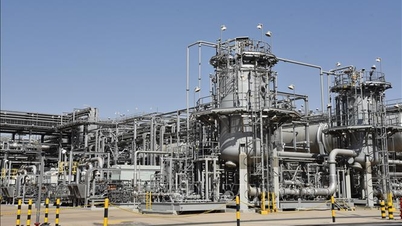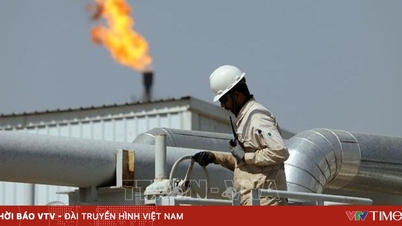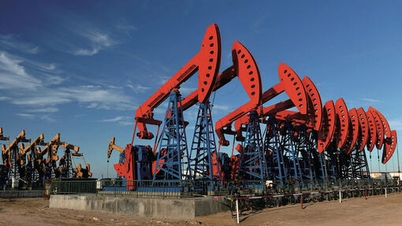Oil prices plunged this week despite the US House and Senate passing a debt ceiling bill. Brent crude oil prices stood at $76.13 a barrel.
World oil prices
According to Reuters , oil prices rose more than 2% at the end of the week's last trading session after the US Congress approved a debt ceiling deal to prevent a government default in the world's largest oil consumer. The rise in oil prices was also influenced by US employment data, which boosted hopes of a possible pause in interest rate hikes by the US Federal Reserve (Fed).
 |
| The sharp increase in the last trading session of the week was not enough to keep gasoline prices climbing this week. Illustration photo: Reuters |
Brent crude for August delivery rose $1.85, or 2.5%, to $76.13 a barrel. U.S. West Texas Intermediate (WTI) crude rose $1.64, or 2.3%, to $71.74 a barrel. This was the highest closing level for WTI since May 26 and Brent since May 29.
For the week, however, both benchmarks fell about 1%. This was the first weekly decline after two consecutive weeks of price increases.
The US Senate has passed a debt ceiling bill, after the House of Representatives passed it. The bicameral passage of the bill would help prevent a default that could rock global financial markets.
Reuters reported that the Fed may skip its first rate hike in more than a year in June after strong US employment data. Non- farm payrolls rose by 339,000 in May. March and April payrolls were revised up by 93,000.
All eyes are now on the June 4 meeting of OPEC+. In April, the group unexpectedly announced a further production cut of 1.16 million barrels per day. The cut has caused oil prices to continuously trade below the previous OPEC+ cut.
Three OPEC+ sources told Reuters that there was debate about additional oil production cuts among possible options.
“Nobody wants to short crude heading into the OPEC+ meeting this weekend,” said Edward Moya, senior market analyst at data and analytics firm OANDA. “Traders should never underestimate what Saudi Arabia will do and take advantage of during OPEC+ meetings.”
Saudi Arabia is the largest producer in OPEC. Its energy minister has warned short sellers betting on falling oil prices to “watch out” for losses.
 |
| Gasoline prices experienced their first weekly decline after two consecutive weeks of increases. Illustration photo: Reuters |
Elsewhere, in the US, energy companies this week cut the most active oil rigs since September 2021. Specifically, the number of oil and gas rigs, an early indicator of future production, fell by 15 rigs to 696 rigs in the week to June 2, the lowest level since April 2022. The total rig count has fallen for the fifth consecutive week.
US oil drillers have cut drilling activity for months as US crude prices have fallen 11% and natural gas prices have fallen 51% since the start of the year.
Domestic gasoline prices
Domestic retail prices of gasoline on June 3 are as follows:
E5 RON 92 gasoline is not more than 20,878 VND/liter. RON 95 gasoline is not more than 22,015 VND/liter. Diesel oil not more than 17,943 VND/liter. Kerosene not more than 17,771 VND/liter. Fuel oil not exceeding 14,883 VND/kg. |
The above domestic gasoline prices were adjusted by the Ministry of Finance and the Ministry of Industry and Trade in the price management period on June 1, with the highest gasoline price increase of 516 VND/liter and the highest oil price decrease of 275 VND/liter (kg).
According to the joint ministries, the world petroleum market is affected by many factors causing petroleum prices to increase and decrease alternately. In this management period, the joint ministries decided to maintain the same level of the Price Stabilization Fund for all petroleum products as the previous period and continue not to spend the Price Stabilization Fund for all petroleum products.
Since the beginning of the year, gasoline prices have undergone 15 adjustments, of which 9 increased, 5 decreased, and 1 remained unchanged.
MAI HUONG
Source






![[Photo] 60th Anniversary of the Founding of the Vietnam Association of Photographic Artists](/_next/image?url=https%3A%2F%2Fvphoto.vietnam.vn%2Fthumb%2F1200x675%2Fvietnam%2Fresource%2FIMAGE%2F2025%2F12%2F05%2F1764935864512_a1-bnd-0841-9740-jpg.webp&w=3840&q=75)
![[Photo] National Assembly Chairman Tran Thanh Man attends the VinFuture 2025 Award Ceremony](/_next/image?url=https%3A%2F%2Fvphoto.vietnam.vn%2Fthumb%2F1200x675%2Fvietnam%2Fresource%2FIMAGE%2F2025%2F12%2F05%2F1764951162416_2628509768338816493-6995-jpg.webp&w=3840&q=75)







































































































Comment (0)